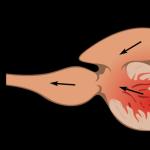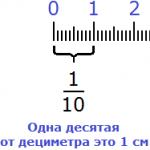Do fish have hearts? The structure of the heart of fish and their blood. Structure of the heart in fish
While cleaning fish, I never thought about where the heart is in the midst of all these offal. I knew that people, mammals, amphibians, birds have it, and fish are completely different. So my awareness of the structure of fish would have remained somewhere at the level of knowledge about the insect world, but finally the truth dawned on me.
Structure of the heart in fish
Rybkin's heart is simple, two-chambered. It is located under the gills and consists of the ventricle and atrium, which contract and push blood throughout the body. The heart beats rarely, 20-30 beats per minute, because fish are a cold-blooded animal. The heart rate increases if the surrounding water is warm.

The fish may die due to the fact that the heart could not withstand the stress. This is how a nervous breakdown and then myocardosis occurred in a black shark at the Kaliningrad Zoo in April 2015. Visitors drove her into panic by constantly banging on the glass to get her attention.
Coelacanth was discovered in South Africa in 1938. Zoologists believed that the fish went extinct millions of years ago, but it is alive and well. This ancient predator has a more primitive and weaker heart than that of modern fish, it looks like a curved simple tube.

Interestingly, Arctic white-blooded icefish:
- have an enlarged heart;
- at rest, they spend 22% of their total energy just to push blood through the body;
- lost red blood cells and hemoglobin to adapt to the extreme temperatures of the north.
I think everyone knows that eating fish is good for our heart. But we are not very useful for fish...
Ancient heart of a ray-finned fish
In 2016, paleontologists discovered the entire fossilized heart of an ancient fish in Brazil. It is already more than 120 million years old! For the first time, a heart has been found preserved in the ancient remains of prehistoric animals. For obvious reasons, this is difficult to do - soft tissues disintegrate without a trace, so prehistoric animals are studied mainly from bones.
It turned out that this heart has a complex structure, five rows of valves. Modern fish no longer have this feature. The find will help to understand how the evolution of the ray-finned fish organism took place.
While cleaning fish, I never thought about where the heart is in the midst of all these offal. I knew that people, mammals, amphibians, birds have it, and fish are completely different. So my awareness of the structure of fish would have remained somewhere at the level of knowledge about the insect world, but finally the truth dawned on me.
Structure of the heart in fish
Rybkin's heart is simple, two-chambered. It is located under the gills and consists of the ventricle and atrium, which contract and push blood throughout the body. The heart beats rarely, 20-30 beats per minute, because fish are a cold-blooded animal. The heart rate increases if the surrounding water is warm.

The fish may die due to the fact that the heart could not withstand the stress. This is how a nervous breakdown and then myocardosis occurred in a black shark at the Kaliningrad Zoo in April 2015. Visitors drove her into panic by constantly banging on the glass to get her attention.
Coelacanth was discovered in South Africa in 1938. Zoologists believed that the fish went extinct millions of years ago, but it is alive and well. This ancient predator has a more primitive and weaker heart than that of modern fish, it looks like a curved simple tube.

Interestingly, Arctic white-blooded icefish:
- have an enlarged heart;
- at rest, they spend 22% of their total energy just to push blood through the body;
- lost red blood cells and hemoglobin to adapt to the extreme temperatures of the north.
I think everyone knows that eating fish is good for our heart. But we are not very useful for fish...
Ancient heart of a ray-finned fish
In 2016, paleontologists discovered the entire fossilized heart of an ancient fish in Brazil. It is already more than 120 million years old! For the first time, a heart has been found preserved in the ancient remains of prehistoric animals. For obvious reasons, this is difficult to do - soft tissues disintegrate without a trace, so prehistoric animals are studied mainly from bones.
It turned out that this heart has a complex structure, five rows of valves. Modern fish no longer have this feature. The find will help to understand how the evolution of the ray-finned fish organism took place.
Important organ
The heart is the main and main organ of any circulatory system. Fish, like humans and other animals, have a heart. This may seem strange, because fish are cold-blooded animals, unlike us. This organ is a muscle sac that constantly contracts, thereby pumping blood to the entire body.
You can find out what kind of heart a fish has and how blood moves by reading the information in this article.
Organ size
The size of the heart depends on the total body weight, so the larger the fish, the larger its “motor”. Our heart is compared to the size of a fist; fish do not have this opportunity. But as you know from biology lessons, small fish have a heart only a few centimeters in size. But in large representatives of the underwater world, the organ can reach even twenty to thirty centimeters. Such fish include catfish, pike, carp, sturgeon and others.

Where is the heart?
If anyone is concerned about the question of how many hearts a fish has, we will immediately answer - one. It’s surprising that this question can arise at all, but as practice shows, it can. Very often, when cleaning fish, housewives do not even suspect that they can easily find the heart. Like humans, the heart of fish is located in the anterior part of the body. To be more precise, right under the gills. The heart is protected on both sides by ribs, just like ours. In the picture you see below, the main organ of fish is designated number one.

Structure
Considering the breathing patterns of fish and the presence of gills, the heart is structured differently than that of land animals. Visually, the shape of a fish’s heart is similar to ours. A small red sac, with a small pale pink sac underneath, is this organ.
The heart of cold-blooded aquatic inhabitants has only two chambers. Namely the ventricle and atrium. They are located in close proximity, or to be more precise, one above the other. The ventricle is located under the atrium and has a lighter shade. Fish have a heart consisting of muscle tissue, this is due to the fact that it acts as a pump and continuously contracts.
Circulation diagram
The fish's heart is connected to the gills by arteries that are located on either side of the main abdominal artery. It is also called the abdominal aorta; in addition, thin veins through which blood flows lead from the entire body to the atrium.
The blood of fish is saturated with carbon dioxide, which must be processed as follows. Passing through the veins, the blood enters the heart of the fish, where, with the help of the atrium, it is pumped through the arteries to the gills. The gills, in turn, are equipped with many thin capillaries. These capillaries run throughout the gills and help quickly transport the pumped blood. After this, it is in the gills that carbon dioxide is mixed and changed to oxygen. That is why it is important that the water where fish live is saturated with oxygen.
Oxygenated blood continues its journey through the fish’s body and is sent to the main aorta, which is located above the ridge. Many capillaries branch from this artery. Blood circulation begins in them, or rather, exchange, because, as we remember, blood saturated with oxygen returned from the gills.
The result is replacement of blood in the fish's body. Blood from the arteries, which usually appears deep red, changes to blood from the veins, which is much darker.

Direction of blood circulation
The chambers of the heart of fish are the atrium and ventricle, which are equipped with special valves. It is due to these valves that blood flows in only one direction, excluding reverse flow. This is very important for a living organism.
Veins direct blood to the atrium, and from there it flows to the second chamber of the fish’s heart, and then to special organs - the gills. The last movement occurs with the help of the main abdominal aorta. Thus, you can see that the heart of the fish makes many endless contractions.

Heart of cartilaginous fish
This is a special class of fish that is characterized by the presence of a skull, spine and flat gills. The most famous representatives of this class are sharks and rays.
Like their cartilaginous relatives, the heart of cartilaginous fish has two chambers and one circulation. The process of exchanging carbon dioxide for oxygen occurs in the same way as described above, only with a few features. These include the presence of a spray, which helps water enter the gills. And all because the gills of these fish are located in the abdominal region.
Another distinctive feature can be considered the presence of an organ such as the spleen. It, in turn, is the final stop of blood. This is necessary so that at the moment of special activity there is a rapid supply of the latter to the desired organ.
The blood of cartilaginous fish is more saturated with oxygen due to the large number of red blood cells. And all because of the increased activity of the kidneys, where their production occurs.
The heart of a fish
This organ itself is a small sac that performs the main function in the body - that is, through contraction it performs the function of pumping blood throughout the body.
The heart size of these waterfowl directly depends on their size. Thus, the larger the size of the fish, the larger this important organ will be. Therefore, such a parameter as the size of a heart the size of a fist is completely unsuitable for fish. Vedas, very small individuals can have such an organ only a few centimeters in size. The largest representatives of this species of animal can have this organ up to thirty centimeters in size. These fish include:
- sturgeon;
- pike;
- soma;
- carp, etc.
Fish Heart Location
 Some people wonder: how many hearts do fish have? Of course, there is one correct answer to this - this is one heart. Many housewives have no idea that they can easily detect this important organ in fish when cleaning it.
Some people wonder: how many hearts do fish have? Of course, there is one correct answer to this - this is one heart. Many housewives have no idea that they can easily detect this important organ in fish when cleaning it.
So where is it located? Everything is very simple. Like in humans or any other animal, in these cold-blooded creatures it is located in the anterior part of the peritoneum. To be more precise, its location is directly under the gills. On both sides of it, like a person, there are ribs that protect it.
The structure of the heart of cold-blooded inhabitants of reservoirs
Since fish live in water, their life requires gills needed. In this regard, the structure of their heart differs from the structure of this organ among the terrestrial inhabitants of the planet. If we evaluate it purely externally, then it resembles a human organ. A small red sac, with a small pale pink sac at the bottom, is this organ.
The fish heart consists of only two chambers, that is, it is two-chambered. This is the main feature of its structure. Its components are the ventricle and the atrium, which are in close proximity to each other. Namely, they are located one above the other. The chambered ventricle is located slightly below the atrium and can be distinguished by its lighter shade. In fish, the heart consists of muscle tissue, due to the fact that it acts as a pump, that is, it constantly contracts.
Found in the ventricle of fish hearts differences in the structure of the myocardium. It is generally accepted that the myocardium of fish is more special and is represented by homogeneous cardiac tissue, which is evenly penetrated by trabeculae and capillaries. The diameter of muscle fibers in fish is smaller than in warm-blooded fish and is approximately 6-7 microns. These values are half as much when compared with other animals, for example, with the myocardium of a dog. This kind of myocardium has a name - spongy.
The heart of cold-blooded inhabitants of water bodies is connected to the gills using arteries. And they, in turn, are located on both sides of the main abdominal artery. This artery is otherwise called the abdominal aorta. It is worth noting that in addition to these vessels, thin veins run throughout the body of such waterfowl that lead to the atrium. Blood flows through these veins.
Fish's blood is saturated with carbon dioxide. They process this gas in a special way.

It follows from this that the water in which fish live must be saturated with oxygen.
At this point the blood circulation process continues . Oxygenated blood, moves further through the body and enters the main aorta, located above the ridge. From this artery many capillaries diverge to each side. Blood circulation occurs in them.
In view of this, it turns out that in the fish body there is a constant replacement of blood. Arterial blood, which has a deep red hue, changes to venous blood, which appears darker.
Veins carry blood to the atrium and from there goes to the second cell. Then it moves to the gills using the abdominal aorta. From this you can see that the heart of a fish makes many contractions that continue all the time.
Fish are cold-blooded aquatic vertebrates that live in both salt and fresh water. Like mammals, fish have a closed circulatory system, meaning blood is always in the blood vessels unless they are damaged. Their circulatory system is quite simple. It consists of the heart and blood vessels. The heart is a primitive muscular structure that is located behind the gills.
The circulatory system of fish consists of the heart and blood vessels
Anatomy and function
The question of what kind of blood is in a fish's heart, and what kind of heart a fish has, was asked by many early researchers, as it is believed that the two-chambered heart played a vital role in the progressive evolution of four-chambered cardiac and vascular circuits.
In fish, this organ is also called the gill heart, because it Its main function is to pump venous blood into the abdominal aorta and gills, and then into the somatic vascular system, so the blood in it is venous.
The structure of the heart of fish is simpler than that of mammals, amphibians and some terrestrial vertebrates. This organ is enclosed in a pericardial membrane or pericardium and consists of four parts:
- atrium;
- ventricle;
- a thin-walled structure known as the sinus vein;
- tube called bulbus arteriosus.

The main function of the fish heart is to pump venous blood into the abdominal aorta and gills.
Although the heart of these animals consists of four parts, it is considered to be two-chambered, since the four parts of the heart do not form a single organ. Usually they are located one after the other. The branchial and systemic blood vessels are located in series with the heart.
In adults, the four compartments are not arranged in a straight row, but instead form an S-shape with the last two compartments located above the previous two. This relatively simpler picture is found in cartilaginous and rayed fish. In bony fishes the conus arteriosis is very small and may be more accurately described as part of the aorta rather than the cardiac organ itself.
Work of the organ
The functioning of the fish heart mainly depends on two factors: heart rate and stroke volume. With each heartbeat, the ventricle pumps out blood. The volume is called stroke volume and the timing of the heart rhythm is known as heart rate.
The atrium of the fish is filled with suction created by the rigidity of the pericardium and surrounding tissue. Venous blood returning to the atrium is accompanied by ventricular contraction in systole, which causes a drop in intrapercardial pressure, which is transmitted through the thin atrium wall to create aspiration effect or font effect.
Fish have a circulatory system in which blood passes through the heart only once during each complete cycle. Deprived of oxygen, it reaches the heart from the body tissues, from where it is pumped into the gills.
Gaseous exchange occurs within the gills, and oxygenated blood from the gills circulates throughout the body.
Blood and cardiovascular system
Fish blood contains plasma (fluid) and blood cells. Red cells - red blood cells contain hemoglobin, a protein that carries oxygen throughout the body. White cells form an integral part of the immune system. Platelets perform functions that are equivalent to the role of platelets in the human body.
Mechanism of blood circulation
Although the cardiovascular system of fish is simple compared to other mammals, it serves an important purpose in illustrating the various stages in the evolution of the circulatory system in animals. The cardiovascular system of fish includes:
- heart;
- veins;
- arteries;
- thin capillaries.
Capillaries are microscopic vessels that form a network called the capillary layer where arterial and venous blood merge. Capillaries have thin walls that facilitate diffusion, the process through which oxygen and other nutrients are carried into cells.
 Capillaries are microscopic vessels
Capillaries are microscopic vessels The capillaries collect into small veins called venules, which in turn merge into larger veins. The veins carry blood to the sinus venosis, which is like a small chamber.
The sinus venous has pacemaker cells that are responsible for initiating contractions so that blood moves into the thin-walled atrium, which has very little muscle.
The atrium creates weak contractions to force blood into the ventricle. The ventricle is a thick-walled structure with a large number of cardiac muscles. It generates enough pressure to pump blood flow throughout the body and into the bulbus, a small chamber with elastic components.
 The ventricle is a thick-walled structure with a large number of cardiac muscles
The ventricle is a thick-walled structure with a large number of cardiac muscles While bulbus arteriosus- this is the name of the chamber in bony fish; in fish with a cartilaginous skeleton, this chamber is called conus arteriosus. The conus arteriosus has many valves and muscles, while the bulbus arteriosus has no valves. The main function of this structure is to reduce the pulse pressure generated by the ventricle to avoid damage to the thin-walled gills.
The outflow tract to the ventral aorta consists of a tubular conus arteriosis, a bulbus arteriosis, or both. Commonly found in more primitive species of fish, the conus arteriosis contracts to help blood flow into the aorta. The ventral aorta delivers blood to the gills, where it is oxygenated, and flows through the dorsal aorta to the rest of the body. (In tetrapods, the ventral aorta is divided into two parts: one half forms the ascending aorta, and the other half forms the pulmonary artery).
Does a fish have a heart?
Sometimes it is very difficult for us to imagine that creatures completely different from us can have organs that are very similar to ours and function in much the same way. Many people think that since a fish lives in water and has cold blood, then it must lack various internal organs or any feelings. In fact, the internal structure of fish is very similar to the structure of higher, warm-blooded animals.
Many scientists believe that this similarity proves that life on land came from the sea! Fish breathe and digest food. They have a nervous system, they feel pain and physical discomfort. They have a very developed sense of touch. They have a sense of taste and also very sensitive skin. They have two small smelling organs in the nostrils located on the head. They even have ears, but they are located inside the body of the fish. Fish have no external hearing organs. The eyes of fish are the same as those of other vertebrate species, but have a simpler structure.
So you can see that fish have "systems" that allow them to perform functions similar to those of our bodies. Let's take a quick look at just two of these systems - digestion and circulation. Food in fish passes through the esophagus into the abdominal cavity, where the gastric glands are located and where food digestion begins. Then it passes into the intestines, where it is absorbed, that is, absorbed into the blood. Different species of fish also have different digestive systems, adapted to different types of food - from plant to other fish. But fish use food for exactly the same purpose as we do: as a source of energy for life, growth and movement.
The fish's circulatory system carries food and oxygen to all internal organs. The pump that regulates the blood circulation of fish, like that of humans, is the heart. The fish's heart is located behind the gills and slightly below them. It has three or four chambers, which, like ours, contract rhythmically.
There are thousands of different species of fish, each adapted to specific living conditions, but their internal organs, senses and systems are similar to ours.




